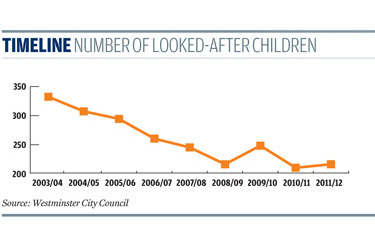How local teams in Westminster are joining forces to close gaps in children's services
Jo Stephenson
Monday, April 16, 2012
Westminster's locality teams are working to help prevent children being taken into care

Project Westminster City Council locality teams
Purpose To improve services for vulnerable ?children and families and reduce the number of children going into care
Funding Westminster council’s annual spend on locality teams is £5.3m
Background Before 2008, Westminster City Council had a fairly traditional set-up when it came to children’s services. Analysis showed resources were focused mainly on either the neediest children and families or universal provision such as childcare, children’s centres, youth services and play. “There was a gap in the middle,” says James Thomas, director of family services.
“Social work, education welfare, young people’s services were operating fairly separately. The way the system was set up meant where you came into the system dictated the response you got, rather than what you actually needed. We needed to get better at delivering the right services to families at the right time.”
Action The solution was a new locality model, which launched in 2009 with locality teams in the north west, north east and south of the borough.
The teams bring together a range of professionals including social workers, education welfare officers, health visitors, parenting workers, youth workers and children’s centre staff with the aim of identifying children at risk as early as possible and taking action before problems escalate.
They offer a wide range of services including outreach work, intensive parenting support, specialist work such as the monitoring of child protection plans and work with gangs. One-to-one and group work is conducted in venues including children’s centres, covering practical topics such as employment advice.
Initially, referrals went to each locality. Now the authority has a multi-agency safeguarding hub, working with police and health colleagues to decide collectively where a referral should go. If a referral comes to a locality team there will be discussion on the best way to handle it.
A core part of the new model has been making an extra effort to work with universal providers such as schools, youth clubs, and early years settings. In particular, a priority for each locality team is working closely with local schools. “We want an integrated children’s services offer in each school, which means getting involved with children that they are worried about at a much earlier stage rather than the more traditional model of schools simply making a referral,” explains Thomas.
The model has undergone further changes and Westminster is in the process of employing a voluntary sector broker to strengthen links with the local community and voluntary sectors. “We work with some well-known names like Action for Children and Home Start but are conscious there are also many smaller organisations including faith-based organisations in churches, mosques and temples or those catering for quite specific groups like the Congolese and Somali communities,” says Thomas.
Outcome The advent of locality teams has coincided with some positive trends including fewer children going into care despite Cafcass figures showing care applications in the county continuing to rise.
“Certainly we have had a number of cases where we have prevented need from escalating ?to statutory intervention,” says Thomas.
Westminster has bucked national trends with a sustained reduction in care proceedings since 2003/04 when there were 41 care proceedings, to 27 in 2011/12.
The number of looked-after children has also fallen, from 331 in 2003/04, to 215 in 2011/12. In 2008/09 there were 145 children on child protection plans, going down to 108 in 2011/12.
The percentage of children who started to be looked after under a care order, police protection, emergency protection order or child assessment order fell from 40 per cent in 2008/09 to 35.5 per cent in 2009/10 to 30 per cent in 2010/11.

If you think your project or programme is worthy of inclusion, email supporting data to janaki.mahadevan@markallengroup.com




